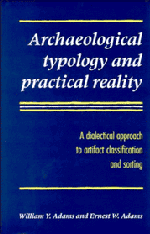 Archaeological Typology and Practical Reality
Archaeological Typology and Practical Reality Book contents
- Frontmatter
- Contents
- List of figures
- List of tables
- The archaeologist's preface
- The philosopher's preface
- PART I Introductory
- PART II The nature of types and typologies
- PART III Typology in action: the Medieval Nubian Pottery Typology
- PART IV Pragmatics of archaeological typology
- PART V Classification, explanation, and theory
- Appendices
- A Glossary of definitions
- B Specimen pottery ware description: Terminal Christian Decorated White Ware
- C Estimated dates for pottery wares found in Nubia
- D Examples of pottery ware distribution data from Qasr Ibrim
- References
- Index
A - Glossary of definitions
Published online by Cambridge University Press: 23 November 2009
- Frontmatter
- Contents
- List of figures
- List of tables
- The archaeologist's preface
- The philosopher's preface
- PART I Introductory
- PART II The nature of types and typologies
- PART III Typology in action: the Medieval Nubian Pottery Typology
- PART IV Pragmatics of archaeological typology
- PART V Classification, explanation, and theory
- Appendices
- A Glossary of definitions
- B Specimen pottery ware description: Terminal Christian Decorated White Ware
- C Estimated dates for pottery wares found in Nubia
- D Examples of pottery ware distribution data from Qasr Ibrim
- References
- Index
Summary
The following definitions are employed throughout the present work as consistently as seems necessary for purposes of conceptual clarity. These definitions are different in many cases from those employed by other authors, and even from the definitions that are normatively used in philosophy and other disciplines. They should be understood as our own definitions, relative to the present work; there is no suggestion that they are or should be the only definitions. Within each definition, words appearing in bold-face type are themselves defined elsewhere in the glossary. At the end of most entries there is a reference to a particular chapter or chapters in this book where the concept under consideration is more fully discussed.
Abstraction. The mental process involved in creating a category, by mentally grouping things together, and thinking of them collectively, on the basis of certain shared characteristics, while ignoring other characteristics that are not shared. (See Chapter 4.)
Acquired gestalt. As used in the present book, a gestalt is an immediate sensory image which we form upon examining a particular entity, and which indicates to us that the entity is a member of a particular type, without any process of conscious analysis. An acquired gestalt is one which we are able to form only after we have had considerable experience in handling the type in question, in contrast to an intuitive gestalt which we are able to form even before types have been formally defined. (See Chapter 4.)
- Type
- Chapter
- Information
- Archaeological Typology and Practical RealityA Dialectical Approach to Artifact Classification and Sorting, pp. 329 - 372Publisher: Cambridge University PressPrint publication year: 1991


